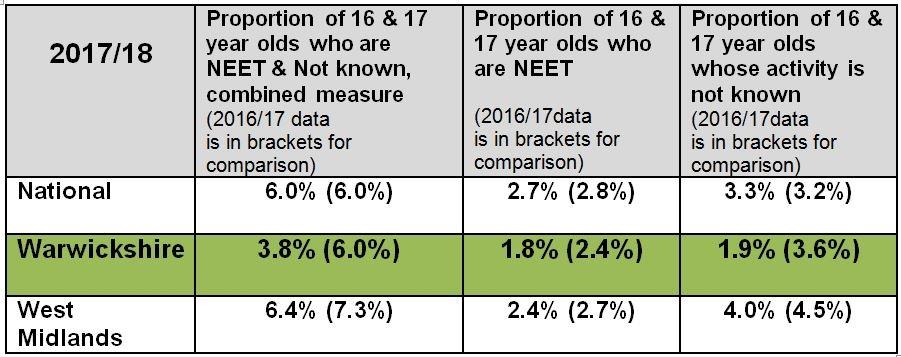Success for Warwickshire’s 16 and 17 year olds
According to a recent report from the Department for Education (DfE) Warwickshire is one of the most successful local authorities in the country for ensuring 16 and 17 year olds are either in education, employment or training.
The DfE require all local authorities to collect and report information about a young person’s post 16 activity on a monthly basis so that a national scorecard can be published. The information collected includes:
- basic information about young people in their area (name and address)
- their needs and characteristics (gender, ethnic group, disability, care leaver)
- their post 16 plans (intended destination, September Guarantee offers)
- their current activity and when it was last confirmed (i.e. education, apprenticeship, employment combined with study, training).
The DfE published the 2017/18* Local Authority NEET (Not in Education, Employment or Training) and Not Known figures on 18th October 2018 available here.
The NEETs group is made up of young people who are not participating in Education, Employment or Training but who are available to the labour market and also those young people who are not currently available to the labour market (for example because of illness, caring responsibilities, pregnancy or parenting responsibilities). The cohort size is based on residency rather than the place of education or training.
In 2017/18 Warwickshire reported a significant improvement in the reduction of the numbers of young people who were NEET, including those 16 and 17 year olds whose activity is not known.
The headline figure (see table below) represents a 2.2 percentage point improvement for Warwickshire since last year.
In 2017/18 there were slightly more males 4.3% (240) within the NEET group than females 3.4% (170).
The Skills for Employment programme has been one of the major contributory factors in this figure decreasing, with schools reporting that the activities implemented as a result of the grant funding have enabled them to reduce the number of students who are NEET. The programme has received an investment of £3 million from Warwickshire County Council over the period 2015/20 in order to improve the employability skills of young people.


2017/18 District level data
The table below details the proportion and number of young people who were NEET and EET in each district at the end of December 2017, January 2018 and February 2018.

* The 2017/18 NEET and not known Figures are an average of the number of young people who were NEET and whose activity was not known at the end of December 2017, January 2018 and February 2018. Three month averages are less prone to statistical blips and provide a more robust assessment of year on year performance.